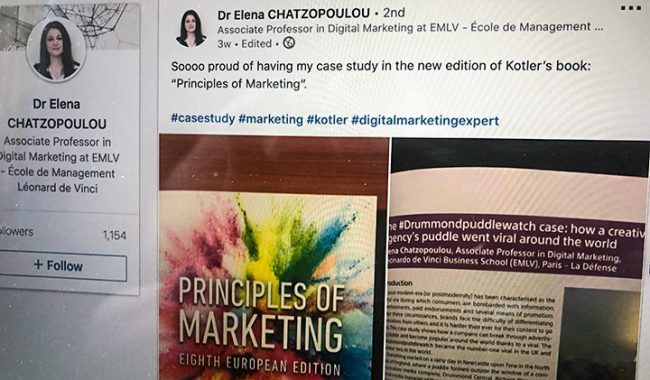Elena Chatzopoulou, associate professor in digital marketing at EMLV, is author of a case study on #drummondpuddlewatch social media phenomenon. The article features in the 8th European edition of Philip Kotler’s Principles of Marketing.
Philip Kotler acknowledged as the father of modern marketing is a world-renowned author of over 60 marketing books, including the bestselling book Principles of Marketing. This textbook is considered the golden standard for teaching future business leaders the analysis, planning and control of marketing activities.
The eight European Edition contains examples of how companies use new digital technologies to maximize customer engagement and impact brand conversations, experiences, and communities.
One of the practical examples showcased in the textbook refers to the British viral #DrummondPuddle and is signed by Elena Chatzopoulou, associate professor in Digital Marketing at EMLV – Leonard de Vinci Higher Education Management School.
The #Drummondpuddlewatch case: how a creative agency’s puddle went viral around the world
Learning objectives
Understand the importance of integrated marketing communication
Learn how to build a successful viral to promote a business
Explore how to manage a viral and make it even more popular
Understand how direct and digital marketing can be successfully applied to increase brand/business awareness
Introduction
The post-modern era (or postmodernity) has been characterized as the digital era during which consumers are bombarded with information, advertisements, paid endorsements, and several promotion means. Under these circumstances, brands face the difficulty to differentiate themselves from others, and it is also harder than ever for their content to go viral.
This case study shows how a company can break through the advertising clutter and become popular worldwide thanks to a viral. The #Drummondpuddlewatch became number 1 viral in the U.K. and number 2 in the world.
Everything started on a rainy day in Newcastle Upon Tyne in the North East of England outside the window of a communication media Company, Drummond Central, where a puddle was formed. Richard Rippon, the company’s social media manager, posted the event via Drummond’s social media (see Picture 1).
Richard twitted a funny message about the puddle, asking how people would tackle the puddle and added the #Drummondpuddlewatch. He added three choices where the audience could vote: jump, parkour, Jesus walk (see Picture 2). Then Richard decided to integrate the social media which Drummond had. He started to do a new thing at the time: the event was streamed live on Instagram live showing how people were trying to jump the puddle, which immediately became trending among social media users.
The audience decoded the message quickly, and all wanted to share the joy of puddle watch. #Drummondpuddlewatch became viral in a couple of hours, and even traditional media broadcast the event in their news.
CNN asked the manager director of Drummond Central for a live interview, and newspapers wrote articles about the puddle and many brands were making posts related to puddles and the #Drummondpuddlewatch.
Business problem
As consumers are daily bombarded with information and promotions, businesses and brands have to position themselves as different and unique.
The information flood solution seems to be the no content marketing that often relies on fun and uniqueness elements. Most companies nowadays follow aggressive promotion strategies.Most companies nowadays follow aggressive promotion strategies.
However, the #Drummondpuddlewatch viral creator, Richard Rippon, reveals that what happened was “a happy accident” and had no intention to run a campaign to promote the company.
Good things happen to good people; however, there is also a logical explanation here. The audience seems to be fed up with advertisements and other promotional material, and so a funny viral with no promotional content is what people are interested in.
If a funny message is transmitted to the audience and does not explicitly advertise a brand/business, it has many chances to become viral.
Moreover, people want to be part of a community and to feel connected. As Beth Hazon, manager director of Drummond Central stated during her live interview on CNN: “People want to be involved in a shared experience”.
In this case, people were also actively involved by going to the puddle. They could be physically there and so people went there with their surf board to pass over the puddle and others were swimming into it (Pictures 3 and 4). These funny videos entertained the viewers who were posting funny messages during the live streaming of the puddle.
The viral started on Twitter and then it moved to Instagram following a successful integration of social media channels. It was also a result of a combination of traditional media and websites that picked up the puddle-watch. The event was given loads of free publicity among websites, newspapers and television. As such, electronic word of mouth bloomed.
It took only a few hours for the puddle to go viral. Unilad and the Poke websites shared the puddle watch case and after lunchtime Drummond’s team had from thousand viewers on Instagram, “a crazy number of viewers”, Richard said. Furthermore, people were talking at their work about the funny phenomenon and they were also sharing the link with the puddle.
All channels had the same message: a funny and humorous approach to a cold and rainy day full of trouble for the pedestrians. This message was simple and so the vast majority of the audience decoded it and got engaged with it.
As Richard argues, “the puddle-watch was for everyone. There was something so marvellously simple about it”.
To read the integrality of the case study: https://www.pearson.com/nl/en_NL/higher-education/subject-catalogue/marketing/kotler-principles-of-marketing-european-edition-8e.html





















